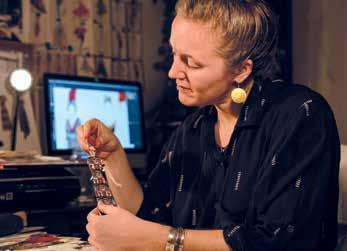
7 minute read
What Inspires You?
AIR PLAY Allen Ying, Communication Design ’04, Photography ’03
Squint a little: Yes, come to think of it, Robert Cronbach’s 1976 bronze sculpture, Eye of Fashion, does resemble a halfpipe. We advise you not to use FIT’s beloved icon that way, but there was a moment in 2004 when someone did. Allen Ying was there to capture it.
“The story with the photo, just the usual,” Ying says. “I met these guys through some other skaters. We were going skating with the goal of getting tricks, footage, and photos, and he saw the sculpture and wanted to try to skate it.” There’s a delicious tension between the airborne performer’s ecstasy and the security guard who’s about to end it.
A photographer who specializes in skaters, Ying founded the late, lamented publication 43 (2011–16) “to push the paradigm of what a skateboard magazine is.” These days he often shoots music acts, publishing on Wait Okay, an ad-free communal blog that he organizes, and Alt Citizen, the online magazine for New York’s Alt Space gallery. Whether they show skaters, musicians, or people hanging out, Ying’s images are transporting. No matter where you see them, when you see them, you’re there.
Fashion Institute of Technology 227 West 27th Street New York, NY 10001-5992
return service requested



Friends for Life In 1962, a professor harshly criticized some drawings by student Steven Stipelman ’63, an aspiring illustrator. Later, Stipelman was approached in the snack bar by new acquaintance Linda Tain ’64, bewildered by criticism from the same teacher. A lifelong friendship began. The following year, as art director for FIT’s yearbook, Stipelman included a shot of them in the Fashion Illustration Club, of Tain in the bookstore, and himself, posing on the escalator. Those first critiques seem to have done little harm: Stipelman was staff illustrator for Women’s Wear Daily from 1964 to 1991, and has taught in the Fashion Design Department since 1993. Tain has taught in the department since 1969; she also held prominent roles in FIT’s union. In 2018, she published a book, Portfolio Presentation for Fashion Designers (Bloomsbury). Both received SUNY Chancellor’s Awards for Excellence in Teaching. Some 57 years after meeting, the two remain close. The color photo (lower right) is from a recent trip to Paris. See a feature about FIT’s yearbooks on page 26.
1. Cut out the hair/hat, leaving the BLUE tab attached.
2. Fold the top of the BLUE tab back toward the blank side.
3. With the blank side facing you, fold forward on the dotted line.
4. Place the hair/hat on the doll with the fold resting on the head. Fold back the other tabs.
VIVIENNE TAM 1995

The Chinese-born, New York–based Tam is noted for designs that fuse East and West. She collaborated with Chinese artist Zhang Hongtu, who created the series of comic images of Mao seen on this multicolor nylon dress—in contrast to the seriousness with which he was traditionally represented.


CHARLES JAMES 1955 James, said to “sculpt” with fabric, used elaborate, rigid structures and fluid folds to create garments that are considered works of art. MFIT has one of the world’s best collections of his dresses, including several versions of this “Tree” evening dress, originally created for Mrs. Reginald Tree. This one is silk taffeta and netting.
JUNYA WATANABE 2002 Watanabe, of Comme des Garçons, is an innovative conceptual designer who often uses advanced technical materials. He made this dress out of vintage blue jeans.
—Valerie Steele
PAUL POIRET 1919 Known for designs that helped free women from corsets, Poiret designed by draping, creating simple shapes that revolutionized modern fashion. His “hobble” skirts, “lampshade” tunic, and harem pants are among his best-known designs. This fancy-dress costume, designed for a ball in Paris, reflects Poiret’s Orientalist aesthetic.
Wearable Art ✁
In honor of The Museum at FIT’s 50th anniversary, and FIT’s 75th, we enable Valerie Steele, the museum’s director and chief curator, to wear clothes from its collection. Sort of.
by Linda Angrilli Illustrations by Anita Rundles ’13
CLOTHES ARE INTIMATE. They’re meant to be on a body, to sheathe that body, to move with that body. And if all goes well, to make that body look fantastic. So it’s a tiny bit sad when a garment is acquired by a museum. Then it becomes a precious object, stripped of its former function. A dress that once walked the runway or sashayed at a downtown club will be kept forever pristine in climate-controlled storage, handled delicately by white-gloved conservators, and exhibited only in dim light that won’t damage fabrics or dyes. It’s there to be admired and studied, but never worn. What if we could somehow reclaim the original purpose of The Museum at FIT’s garments? What if someone could put them on? We could think of only one way—and one someone. And so we turned Valerie Steele—director and chief curator of MFIT, Yale PhD, iconic historian of fashion, respected scholar, frequent media commentator, and author of 31 books (some translated into languages including Chinese, French, and Russian)— into a paper doll. Now she can model pieces from the museum’s collection, even if only in two dimensions. “I would never wear a dress from the museum’s collection!” Steele said. “But it’s fun to fantasize about it.” The garments here are all by leading 20th century designers, and were among the pieces featured in the museum’s anniversary show, Exhibitionism: 50 Years of The Museum at FIT, held last spring.
To learn about these designs, see the reverse of each outfit.

Tim Gunn, President Joyce F. Brown, and Steele at the opening of Exhibitionism: 50 Years of The Museum at FIT.
Produced by
The Museum at FIT, accredited by the American Alliance of Museums, is one of a select group of specialized fashion museums around the world, including the Musée de la Mode (Paris), the ModeMuseum (Antwerp), and the Museo de la Moda (Santiago). The museum has a collection of more than 50,000 garments and accessories from the 18th century to the present, including avant-garde fashions by leading designers. Its innovative and award-winning exhibitions are both educational and inspiring, attracting more than 100,000 visitors each year. MFIT celebrated its half-century mark in 2019, with Exhibitionism: 50 Years of The Museum at FIT, a show highlighting more than 30 of its most influential exhibitions dating back to the 1970s. Its groundbreaking shows include Fashion and Surrealism (1987), The Corset (2000), A Queer History of Fashion: From the Closet to the Catwalk (2013), and Pink: The History of a Punk, Pretty, Powerful Color (2018). For more on The Museum at FIT, visit fitnyc.edu/museum.

How a Real Person Became a Paper Doll
When Valerie Steele agreed to be turned into a paper doll, we went straight to Anita Rundles, Illustration BFA ’13, an accomplished artist with an uncanny ability to render the drape and texture of fabric. (She created the cover art for our fall 2017 innovation issue, of an 18th century woman in a VR headset, which won a CASE Circle of Excellence Award.) She’s also a fan of paper dolls, and was excited to jump in. She went to the museum’s 50th anniversary show, Exhibitionism, to see the outfits up close, and then worked from photos to create the details. Her images are both gorgeous and accurate, representing each garment with remarkable sensitivity. Of course, the doll had to be just so, and the signature cat’s-eye glasses had to be perfect. We tried several poses, and picked one that showed the garments well—and would be easy to cut out if readers wanted to. We had fun cutting them out ourselves to make sure everything fit and the tabs worked properly.
Once we decided to include Paul Poiret’s harem costume with its feathered headdress, the doll’s hair had to lie close against her head. But that hair looked wrong with some of the garments, so Anita created other hairstyles that Valerie has worn, including her simple, sleek everyday style.
Valerie Steele the human was pleased when she saw Valerie Steele the paper doll’s fabulous wardrobe. We think you will be too.
Grab your scissors or find an interac- tive version of this feature online at hue.fitnyc.edu. ✂

Do not cut out white area between arm and body.


Exhibitionism (2019) commemorated more than 30 of the most influential MFIT shows, including Fashion and Surrealism (1987), a groundbreaking exploration of the relationship between art and fashion.
MFIT

Sergey Shinderman










